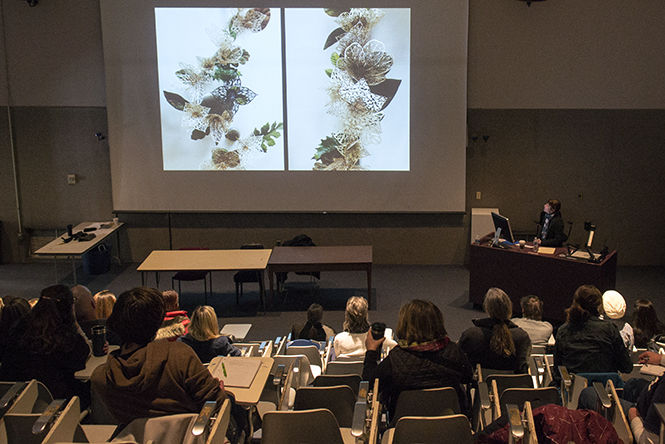Artist shows Kent State audience “fragility of human spirit” through textiles
Artist Piper Shepard talks to art students about her practice on Friday March 6, 2015. Shepard works with cloth cutting them into intricate lace designs.
March 7, 2015
A guest artist showed Kent State students how textiles can be more than just fabric and can show the fragility, delicacy and humanity of the human spirit during a lecture on Friday, March 6.
Janice Lessman-Moss, head of the textile arts program, organizes Friday lectures and said she was excited to have textile artist Piper Shepard speak, so students could see the “the trajectory of somebody’s work.”
“Our program (offers) a lot of different processes — we do weaving, we do screen printing on fabric, we do felt-making, dimensional basketry and surface design,” Lessman-Moss, an art professor and division coordinator of crafts, said. “We cover a lot of bases. I try to have somebody who focuses on a different process.”
Shepard uses a process of cutting lace-like fabric into different shapes and structures in her work. She presented photos of her art installations, which were large, intricate lace-cut pieces hanging from the ceiling and against windows.
“I heard her lecture at the Cleveland institute of Art maybe 10 years ago, and I’ve always admired her work,” Lessman-Moss said. “I like Piper because she works in a repeat pattern. It’s like a drawing in space. She really uses light and shadow.”
Fragility, delicacy and transparency are all aspects of Shepard’s work as well as characteristics that every person has at different points in their life.
“I’m taking a substrate, and I’m deconstructing it by cutting into it, but as I’m cutting into it, I am developing and creating the pattern out of it,” Shepard said. “I think of the ethereal, delicate and fragile, not only as conditions in the work itself but also their … human conditions.”
Shepard said that she uses perseverance and brick-by-brick construction of architecture to build her work.
Shepard was influenced by women who worked in textiles in the 1970s, she said, but her artistic interest originally grew from a young age as she was raised by an artistic mother who had always made and painted landscapes.
“I had that (art) around me all the time,” Shepard said. “Whether she (her mom) knows that or not, all that rubbed off on me.”
Shepard first attended University of Bridgeport in Connecticut as a painting major and transferred to Philadelphia College of Art where she had some friends who were in fiber — something she was unfamiliar with.
Shepard said she was impressed and fascinated by the different process that fiber could create as well as its functionality.
“I really liked the kind of work that was coming out of the studio, and I liked that I was going to learn something that has a familiarity to it because of course put it on every day but also could be very experimental,” she said. “So, that’s why I started to work in fiber.”
Traveling is an influence and inspiration for Shepard’s work. She found her love of ornament and pattern in textiles from a trip to India.
“Travel expands your horizons,” Shepard said. “You develop a sense of understanding the world in a greater way more than if you would’ve stayed home. The importance of traveling is to learn from a culture.”
She feels that travel lets her put together the pieces to understand people, culture and her place.
Junior textile major Abby Schnure said she also admired Shepard’s use of handwork, especially because everything is laser-cut and mill weaved due to the available technology.
“I didn’t really look at her work before it (the lecture), so I got to see it for first time (and) was really interesting, especially because it’s something we don’t really do here (the textile program at Kent State), of lace work,” Schnure said. “To see a different type of fiber art is always really interesting.”
Sarah Kauffman, senior fashion design major who has a textiles minor, said it was great to see how she applied her art to architecture.
“I really loved her body of work,” Kauffman said. “She has a very unique approach to a very historic fabric.”
Kauffman said she feels textiles are important to her discipline of fashion and as an artist.
“I think as far as fashion design, I think being able to design with textile, you have to design a silhouette from taking it from one dimension to three dimension, to be more unique,” Kauffman said.
Contact Dara Sander at [email protected].

























